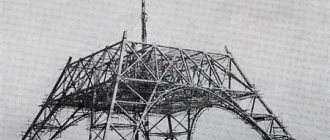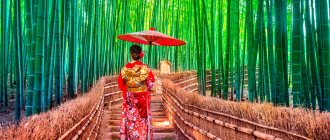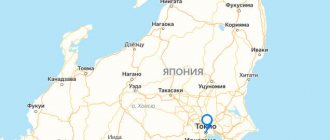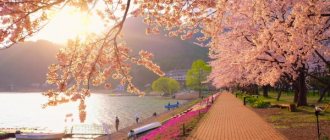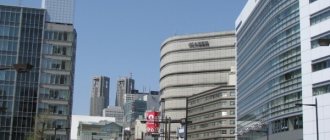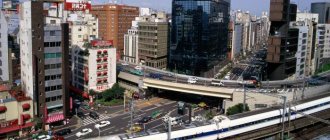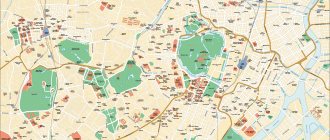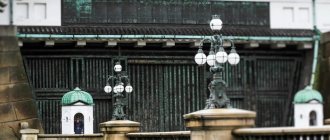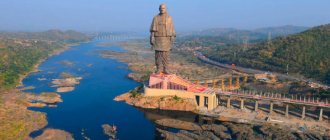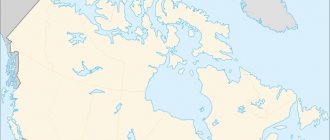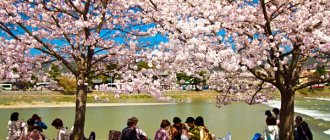“Tree of Heaven” (Tokyo): photos and general characteristics of the tower
The Tokyo Broadcasting Tower is one of the top 5 largest television towers in the world. Moreover, it is the absolute leader in height among other similar structures. This is clearly visible in the diagram below. It is taller than the famous Canton Tower in Guangzhou and almost a hundred meters higher in height than the Ostankino Tower.
The name of the Tokyo Tower is beautiful and symbolic - “Tokyo Sky Tree”. He was chosen by popular vote via the Internet. The design height of the Sky Tree in Tokyo is 634 meters (including antenna). The total number of floors is 29. The tower houses 9 different television companies and two radio broadcasting companies.
By the way, the product line of the famous Chinese manufacturer Loz includes the “Tokyo Sky Tree” construction set (630 pieces). It is curious that the total number of parts in it is 630, which is almost equal to the height of the real building. The construction set consists of modern nanoparts, which allows you to assemble a model that is as close as possible in appearance to the original.
The world's tallest television tower, Tokyo Skytree, Tokyo, Japan
The tallest television tower at the moment is the Tokyo Skytree , which is located in the Sumida area, Tokyo , Japan . It is the tallest among the television towers in the world, its height is 634 meters and the second among the tallest buildings in the world, the first is the Burj Khalifa in Dubai with a height of 828 meters.
The new Tokyo Tower, "Tokyo Sky Tree" or "Tokyo Sky Tree" , was built to replace the old Tokyo Television Tower, to transmit digital television and radio signals, since from 2011 all television broadcasting in Japan was to switch completely to digital television broadcasting. The old one was not high enough to transmit to the upper floors of some skyscrapers.
Construction of the Tokyo Skytree began in July 2008 and the speed with which the Japanese built this structure is amazing - 10 meters per week. Construction was completed on February 29, 2012, although it was planned to be completed in December 2011, but due to the earthquake, funds allocated for the construction of the television tower became less and it slowed down. The official opening took place only on May 22, 2012. 580 thousand people took part in the construction of the television tower and 812 million dollars were spent.
The tower is built with modern anti-seismic systems, which, according to engineers, can absorb up to 50% of the energy of an earthquake, and can theoretically withstand earthquakes of magnitude 7.0 with the epicenter under the tower.
The name of the tower "Tokyo Skytree" was chosen based on the results of a popular vote that took place on the Internet from April to May 2008. The name received about 33,000 votes (30 percent) out of 110,000 voters, with the second most popular name being "Tokyo Edo Tower".
The height of the television tower is twice as high as the Tokyo Television Tower and during the design was chosen to be equal to 634 meters. This is not just like that, the fact is that the number is 6 (pronounced “mu” in old Japanese), 3 (“sa”), 4 (“si”) and together they sound like “Musashi”, which is consonant with the name the historical area where modern Tokyo is located - "Musashi" .
The Tokyo Sky Tree Tower is used primarily for digital television and radio broadcasting, mobile telephone communications and navigation systems, but it is also a popular tourist attraction. It has two public viewing platforms. The first observation deck is located on 3 floors at an altitude ranging from 340 to 350 meters, which can be reached in 60 seconds by the fastest elevator in Japan, which surpassed the Landmark Tower elevator in Yokohama in speed. Part of the floor of the observation deck is made of strong glass, where you can see the city right under your feet. There is also a cafe, a small souvenir shop and a restaurant (Musashi Sky Restaurant).
The next elevator takes visitors to the second observation platform of the Tokyo Skytree , which is located at an altitude of 445 meters, called the Skywalk, a circular path that runs around the tower 360 degrees, rising 75 meters in height. height to the highest point of the tower (451.2 m) accessible to visitors.
Tokyo Solamachi shopping and entertainment complex , which is located on the banks of the Sumida River and contains more than 300 shops and restaurants. There is also a postal museum, office space, a planetarium and a huge aquarium (Sumida Aquarium). The entrance to Tokyo Sky Tree with ticket office is located on the 4th floor of the complex.
Construction process
By the end of the 2000s, Japan had to completely abandon analogue television and switch to digital format. However, it soon became clear that the main (at that time) Tokyo television tower was too low and could not provide high-quality data transmission to the upper floors of many skyscrapers. The Japanese made a decision: to build a taller tower.
Construction began in the summer of 2008 and was completed in May 2011. A year later, its grand opening took place. The pace of construction was truly impressive - up to 10 meters per week!
The parameters of the land plot allocated for the construction of the “Sky Tree” in Tokyo were minimal - 400 by 100 meters. It was simply impossible to lay a traditional square foundation of the required size on this piece of land. Therefore, the architects decided to erect a tower on a triangular foundation with a width of 68 meters on each side.
Then the creators faced another problem. It was necessary to build circular observation platforms that would provide a 360-degree panoramic view of the city. The designers found a solution: they began to build the tower from a triangular base, gradually rounding its shape.
History of the construction of the Tokyo Tower
For more than 50 years, television broadcasting in the Japanese capital was carried out by the “old” Tokyo Tower, commissioned in 1958. At the time of its construction, it was the most advanced and tallest steel structure in the world (332.6 meters). But by the beginning of the 21st century, “Tokyo Tawa,” as the Japanese liked to call it, distorting the English phrase “Tokyo tower,” was no longer the largest building in the capital, and technically did not satisfy the government’s requirements to transfer all of the country’s television to a digital broadcast format by July 2011 of the year. The high-frequency signals emitted by Tokyo Tawa did not reach the upper floors of skyscrapers, as well as regions surrounded by forests. A decision was made to build a new Tokyo television tower.
The design of the future structure was presented to the public on November 24, 2021 . It was based on three paradigms, which were supposed to emphasize the national flavor and technological excellence of the structure:
- Neo-futuristic look combined with the aesthetics of Japanese architecture;
- Increased attention to the stability of the building during strong earthquakes;
- Revitalizing life in a once quiet part of the city by increasing tourist attractiveness.
Construction work began in July 2008 and progressed at an astonishing rate of 10 meters per week! Already on May 22, 2012, the grand opening of a new infrastructure and tourist facility in the capital of Japan took place, which could have happened even earlier - in 2011 - but was disrupted due to the earthquake, which shifted the work schedule and greatly slowed down the pace that had been gained from the very beginning.
Most of the budget - 750 million euros - was spent on the creation and implementation of a unique earthquake resistance system for the building. According to the chief engineer, this know-how is capable of compensating up to 50% of the force of tremors , which makes the television tower incredibly stable even during severe natural disasters typical of a small island state.
Architectural features and design
At the design stage, no less than forty different models of the future tower were created. As a result, the commission chose the project that was the most reliable. The design of the tower uses arcs that are very reminiscent in shape of samurai swords. The authors of the project also studied in detail the architecture of ancient Japanese temples with convex columns.
In general, the design of the tower can be described as “neo-futuristic”, but with elements of traditional Japanese architecture. Thus, in some of its elements the structure resembles five-tiered pagodas. Increased attention was paid to the issue of safety. Thus, the Tokyo Sky Tree tower was built taking into account the latest anti-seismic technologies and is capable of absorbing 50% of the energy of an earthquake. Theoretically, the “Heavenly Tree” can withstand even shocks of 7 points.
The construction of the Sky Tree in Tokyo cost $812 million. In total, over half a million people took part in the construction work.
Tower observation decks
The roof of the “Heavenly Tree” is located at an altitude of 470 meters. Everything above is, in fact, an antenna. The first observation deck is located at 350 meters. Everyone is brought here by a high-speed elevator, which covers this distance in 30 seconds. To cope with a sharp change in altitude, it is recommended to take a few candies with you to the tower.
You can go up to the second observation deck by escalator. Extreme lovers will appreciate this place, because here you can stand on a transparent glass floor at a stunning height. It is from here that a wonderful view of the multi-million metropolis opens. Tokyo looks especially beautiful from the Sky Tree in the evening.
While going down from the tower, tourists can also do some good shopping. The first five floors of Tokyo Sky Tree are a shopping and entertainment center with cafes, restaurants, numerous shops, as well as an aquarium and planetarium.
Usage
The tower is mainly used for digital television and radio broadcasting, mobile telephony and navigation systems.
In addition, it is a popular tourist attraction: in the TV tower you can visit 2 observation decks, and there are also a large number of boutiques and several restaurants open there, and at the foot of the tower there is a mini-complex with a large shopping area, an aquarium and a planetarium[17].
Television and radio broadcasting
The tower has adopted most of the functions of the Tokyo Television Tower, in addition, over time the broadcast volume will be doubled, and due to the fact that broadcasting is carried out from a height exceeding 600 meters, the broadcast area for the 1seg[en] format (format for transmitting digital television to mobile phones and terminals) will be significantly expanded.
TV broadcasters
| Channel | Channel name | Callsign | Signal strength | Broadcasting territory |
| 1 | NHK General TV[en] / NHK G (GTV) | JOAK-DTV | 10 kW | "Greater Tokyo" |
| 2 | NHK Educational TV[en] / NHK E (ETV) | JOAB-DTV | Kanto | |
| 4 | Nippon Television/Nittele (NTV) | JOAX-DTV | ||
| 5 | TV Asahi/Tele-Asa (EX) | JOEX-DTV | ||
| 6 | TBS | JORX-DTV | ||
| 7 | TV Tokyo/Teleto (TX) | JOTX-DTV | ||
| 8 | Fuji Television (CX) | JOCX-DTV | ||
| 9 | Tokyo Metropolitan Television/Tokyo MX | JOMX-DTV | 3 kW | Tokyo |
Broadcasting
| Frequency | Station name | Callsign | Power | ERP | Broadcasting territory |
| 81.3 MHz | J-Wave[en] | JOAV-FM | 7 kW | 57 kW | Tokyo |
| 82.5 MHz | NHK Tokyo FM | JOAK-FM |
Tokyo Sky Tree: information for tourists
An extremely unpleasant moment: it is not possible to purchase an entrance ticket to Tokyo Tower via the Internet. This can only be done by residents of Japan. Therefore, you will have to buy a ticket on the spot. Fortunately, there is a quick queue designed specifically for foreign tourists. It is located on the 34th floor.
If you are planning to visit the Sky Tree Tower in Tokyo, we recommend arriving early. There are always a lot of people who want to come here. Often you have to wait in line for about half an hour. The easiest way to get here is by metro (Oshiage Station, Narita Line). Tower address: Oshiage 1-1-13, Sumida-ku, Tōkyō-to 131-0045.
The entrance ticket costs 2060 Japanese yen (about 20 dollars, or 1200 rubles). For children, depending on age, there are various discounts. In case of strong gusts of wind, access to observation platforms may be limited.
